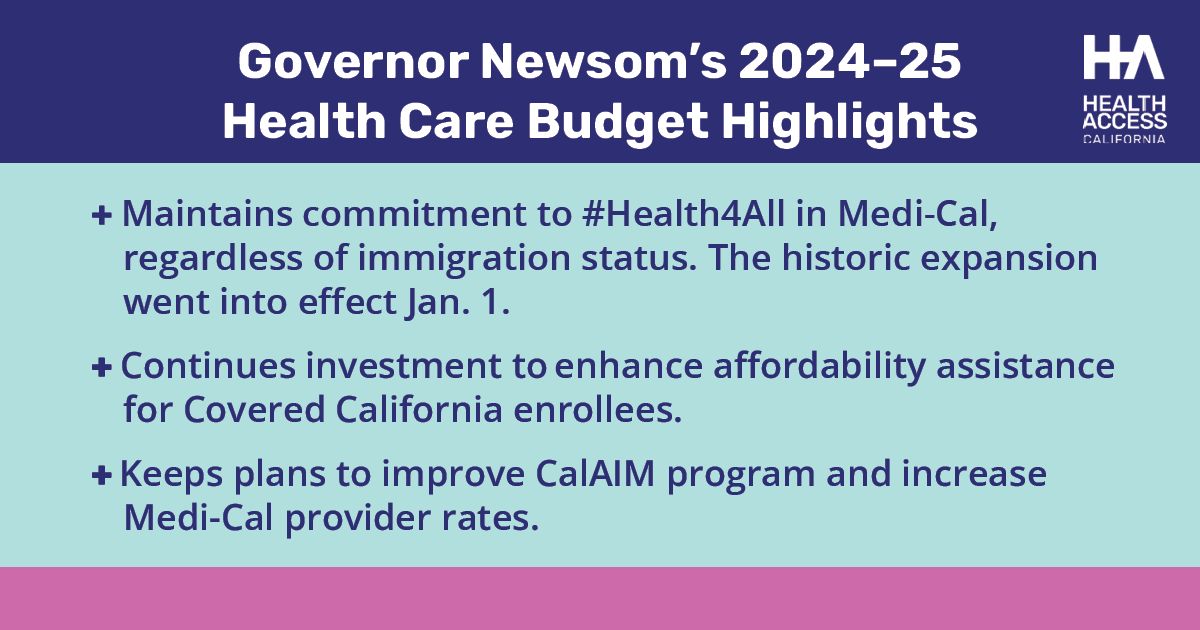- Despite a deficit, the 2024-2025 state budget proposed by Governor Gavin Newsom continues key commitments in health care, particularly in Medi-Cal with improvements in rates and access, benefits, quality and equity, and eligibility, and keeping Medi-Cal available for all income-eligible Californians regardless of age or immigration status.
- As Californians face rising cost-of-living pressures, and higher health costs specifically, health and community advocates were heartened to see no change in the plan to increase affordability assistance to lower out-of-pocket costs in Covered California.
- More than half a million Californians remain locked out of health care access due to income and immigration status. Health advocates look to the Legislature to take additional steps to make health care more accessible, allowing all to purchase plans in Covered California with their own dollars.
SACRAMENTO, CA – Today Governor Gavin Newsom released his proposed 2024-25 state budget, which continues key commitments to expanding health care access and affordability.
Health advocates express relief that despite a deficit, the proposed budget kept in place a range of investments over the last several years in Medi-Cal that have improved benefits, rates, access, and eligibility, including removing barriers based on age and immigration status. The proposal also continues an investment to lower out-of-pocket costs in Covered California, which is already contributing to increased enrollment for 2024.
“Californians can be relieved that despite a deficit, no one is losing access or affordability assistance to needed care and coverage. We appreciate the Governor’s continued budget commitment to expand Medi-Cal and improve our health care system for all Californians,” said Anthony Wright, executive director of Health Access California, the statewide health consumer advocacy coalition. “Over the last several years, California has made important investments to make Medi-Cal and coverage more accessible, affordable, and accountable, and those and other reforms should continue regardless of age, income, or immigration status. Health coverage benefits not just individuals who work, pay taxes, contribute to our economy and society, but their families, and our communities overall.”
“Our budget reflects our values and our needs, and prioritizes what we learned during the pandemic, that our health is dependent on the health and wellness of our community members, from our neighbors to the essential workers we rely on. This budget recognizes that our health system is stronger when everyone is included–getting primary and preventive care, reducing unnecessary and expensive emergency room care, and leading to a more efficient, effective, and financially sustainable system of hospitals and clinics that we all rely on,” said Wright.
Other budget investments continue to build on the CalAIM program to transform service delivery for high-needs individuals through Medi-Cal, implement the Master Plan on Aging, and maintains plans to improve Medi-Cal provider rates.
In addition to Medi-Cal improvements, key affordability measures for those in Covered California were also preserved. As Californians face rising cost-of-living pressures, and higher health costs specifically, the Governor’s budget proposal makes no change to the plan to lower out-of-pocket health care costs in Covered California. This year deductibles were eliminated, and co-pays were slashed for tens of thousands of Californians who earn under 250% of the federal poverty level and purchase their care through the state’s health exchange. This improvement in affordability has already shown results, leading to an 18% increase in enrollment over the same period last year and the highest during this same period in four years according to Covered California.
“While we recognize the realities of the budget deficit, our policymakers have appropriately been building reserves and flexibilities for a decade to be ready to continue its commitments in the face of a revenue downturn. Californians continue to feel the pressure of the increased cost of living, so we need to continue the work to bring down health costs and ensure every Californian can access and afford health care and coverage,” said Wright.
More than half a million Californians remain locked out of health care access due to income and immigration status. In 2024, health advocates look to the Legislature to take additional steps to make health care more accessible, allowing all to purchase plans in Covered California with their own dollars through AB 4 (Arambula).
###
